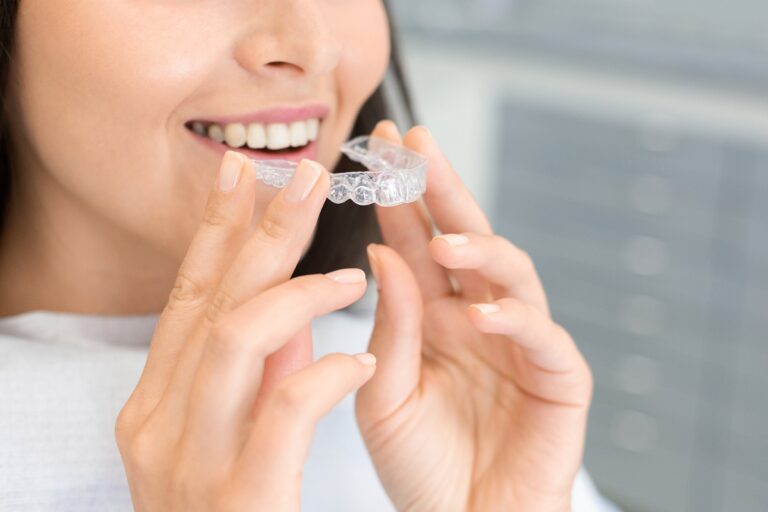Invisalign Vs Braces: What Are the Differences?

Invisalign Vs Braces: What Are the Differences?
What are the differences between Invisalign vs braces?
- Consultation
- Appearance
- Comfort
- Diet
- Care and maintenance
Misaligned teeth can cause discomfort when chewing, affect your speech, and increase the chances of cheek biting. In some cases, it can also affect your confidence in speaking in front of other people. But the good news is, you can say goodbye to these problems with a little bit of commitment, patience, and motivation. Depending on your situation and preference, you can consider Invisalign vs braces. To help you, here are the differences between each treatment.
Consultation
To know if you’re eligible for braces or Invisalign treatment, the first thing you should do is schedule an appointment with an orthodontist. They specialize in diagnosing, preventing, and treating misaligned teeth and jaw.
Both Invisalign trays and braces treat different cases of misaligned teeth. From crowded teeth, gap teeth, overbite, underbite, crossbite, and open bite—both are effective in correcting your smile. But when it comes to severe cases such as rotated and overlapping teeth, traditional braces will be recommended by your dentist.
Before an orthodontist can attach the braces, they will take diagnostic pictures and require x-rays. A mold will be placed on your mouth to take an impression of your teeth. For an Invisalign treatment, your dentist will take a digital impression using a digital scanner.
Appearance

One of the most obvious differences between Invisalign aligners and traditional braces is their appearance. Because of the metal wires and colorful rubber, the latter is more noticeable. But more and more people are wearing braces without compromising their confidence and ability to talk to other people. After all, it’s a sign that you’re committed to improving yourself. Instead, you can own it knowing that there will come a day when you won’t be wearing it anymore.
Compared to braces, Invisalign aligners give you a more discreet method of teeth alignment. The tray is made with a clear material so it is not noticeable from afar. You can also remove it for a short time if you want to take self-portraits, need to speak at a special event or want to eat.
Comfort
Teeth alignment treatments involve temporary discomfort especially if you’re wearing the aligners and braces for the first time. These devices slowly move your teeth in the right position over time, so you might feel some pain at some times. The good thing is, these typically subside as you get used to wearing them.
When you first wear braces, your mouth might feel sore for a few days. To solve this, you can take a pain reliever and stick to soft foods for the first week. After a month, you will get used to wearing them. When your braces get tightened and adjusted during your monthly dental visits, you might also feel some discomfort but it won’t be as bad as the first time.
Invisalign aligners put less pressure on the teeth, although you will also feel some discomfort when wearing them for the first time. But because aligners are made with a smooth material, this feeling will subside quickly. Instead, you might need time to get used to a lisp as your tongue re-learns how to form shapes when you’re speaking with an aligner.
Diet

If you need to get your teeth aligned, you might need to modify your diet. Otherwise, the wrong types of food and beverages and get stuck, stain, or damage the teeth aligning device you’re wearing. The discomfort at the beginning might also affect your eating habits.
For instance, if you’re wearing traditional braces, your orthodontist will recommend soft foods such as mashed potatoes, yogurts, scrambled eggs, and pasta during the first few days. After that, you might be also advised to avoid sticky and hard foods that can damage the wires and brackets.
When you’re wearing an Invisalign tray, you can remove it for a short period of time to eat and drink what you want. But if you get thirsty while wearing them, you can only drink clear liquids. Tea, wine, and coffee can stain the aligners.
Care and Maintenance
Both braces and Invisalign aligners require care and maintenance if you want them to be effective. A consistent oral hygiene regime is also a must if you don’t want to develop tooth decay from food debris that can get stuck on and in between your teeth.
If you’re wearing traditional braces, you need to brush and floss between your teeth to get rid of particles of food. Avoid chewing hard food as this can damage the brackets and the metal wires. You also need to go back to your dentist for adjustments every 4-6 weeks to have your braces tightened.
Follow-up-visits for Invisalign aligners are fewer and have longer intervals compared to when you’re wearing braces. Instead of adjustments, your doctor will provide you with custom trays that you need to change every few weeks. Be careful when storing and using them because replacements can take time to be made. With Invisalign, you need to brush your teeth every time you eat so it also requires commitment on your part.
Key Takeaway
Both Invisalign aligners and braces are effective in fixing misaligned teeth. Although there are some differences, you will need enough patience and commitment to achieve your dream results with either of these treatments. With the help of an orthodontist and the motivation to transform your smile, this will be one of the best decisions you can make for your oral health.
If you want to know more about Invisalign vs braces, you can set a dental appointment at one of Casipit Dental Group’s branches! This way, an experienced orthodontist can recommend what is the best choice for your condition, lifestyle, and preference.












